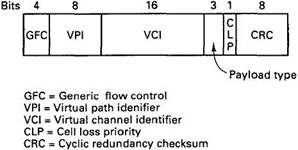Книга: Distributed operating systems
2.2.3. The ATM Layer
2.2.3. The ATM Layer
When ATM was being developed, two factions developed within the standards committee. The Europeans wanted 32-byte cells because these had a small enough delay that echo suppressors would not be needed in most European countries. The Americans, who already had echo suppressors, wanted 64-byte cells due to their greater efficiency for data traffic.
The end result was a 48-byte cell, which no one really liked. It is too big for voice and too small for data. To make it even worse, a 5-byte header was added, giving a 53-byte cell containing a 48-byte data field. Note that a 53-byte cell is not a good match for a 774-byte SONET payload, so ATM cells will span SONET frames. Two separate levels of synchronization are thus needed: one to detect the start of a SONET frame, and one to detect the start of the first full ATM cell within the SONET payload. However, a standard for packing ATM cells into SONET frames exists, and the entire layer can be done in hardware.
The layout of a cell header from a computer to the first ATM switch is shown in Fig. 2-5. Unfortunately, the layout of a cell header between two ATM switches is different, with the GFC field being replaced by four more bits for the VPI field. In the view of many, this is unfortunate, since it introduces an unnecessary distinction between computer-to-switch and switch-to-switch cells and hence adaptor hardware. Both kinds of cells have 48-byte payloads directly following the header.

Fig. 2-5. User-to-network cell header layout.
The GFC may some day be used for flow control, if an agreement on how to do it can be achieved. The VPI and VCI fields together identify which path and virtual circuit a cell belongs to. Routing tables along the way use this information for routing. These fields are modified at each hop along the path. The purpose of the VPI field is to group together a collection of virtual circuits for the same destination and make it possible for a carrier to reroute all of them without having to examine the VCI field.
The Payload type field distinguishes data cells from control cells, and further identifies several kinds of control cells. The CLP field can be used to mark some cells as less important than others, so if congestion occurs, the least important ones will be the ones dropped. Finally, there is a 1-byte checksum over the header (but not the data).
- 2.2.2. The ATM Physical Layer
- 2.2.4. The ATM Adaptation Layer
- 4.4.4 The Dispatcher
- About the author
- Chapter 7. The state machine
- Appendix E. Other resources and links
- Example NAT machine in theory
- The final stage of our NAT machine
- Compiling the user-land applications
- The conntrack entries
- Untracked connections and the raw table
- Basics of the iptables command




